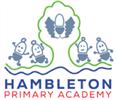Hambleton Primary Academy
Art Provision Map

Area of Need Universal Provision
Cognition and Learning
● Clear, simple language for explanations
● Inclusive curriculum where children are encouraged to make decisions and access resources appropriate for their level
● Checking understanding frequently
● Instructions supported with adult modelling
● Retrieval questions to recall previous learning
● Exploration elements of lesson for children to express themselves as artists
● Targeting questioning to help children learn
● Flexible grouping
● Pupils learning from one another
● Adaptive technology for accessing the curriculum
● Adaptive technology for recording work
● Adapted resources for different needs
● Assistive technology
● Small group work
● Greater emphasis on aural memory skills
● Use larger print/symbols/colour codes
● enable pupils to research recommended websites online − eg websites of museums, galleries and exhibitions
● capture images or processes and replay them at different speeds and at different magnifications to support pupils’ knowledge, understanding and skills in practical work
● Show scanned, photographed or videoed outcomes from the previous lesson’s work using an interactive whiteboard, and explore possibilities for the next steps. Display step-by-step reminders of key processes.
● Incorporate EHCP strategies and targets throughout the lesson eg physical and gestural support eg hand on hand modelling with different medium
● Follow advice from multidisciplinary team
Communication and Interaction
● Clear structured lessons
● Clear, simple language for explanations
● Checking understanding frequently
● Instructions supported with images, diagrams
● Modelling
● Recalling previously learnt vocabulary
● Visual timetables
● Small step instructions
● Processing Time
● Clear expectations of how to interact
● Targeting questioning to assess understanding
● Peer on peer support
● Adaptive technology for communication
● Adaptive technology for recording knowledge
● Adaptive seating and working areas
Emotional, Behavioural and Social
● Inclusive PSED/RSE curriculum
● Restorative approach to behaviour
● Trauma informed approach to behaviour
● Caring and positive Ethos
● Planned opportunities to build resilience
● Explicit teaching of appropriate interactions and engagement with others
● Teaching about and how to manage feelings
● Development of Opal Play to promote resilience, interactions, teamwork
● Consistent reward systems
● Assemblies and book enhanced curriculum
● Access to fidget toys
● Now and Next board
● Communication aid
● Encourage different forms of communication e.g. gesture
● Highlight: key vocabulary linked to learning objectives, practical skills, and things to observe
● Use puppets and/or pictures, which add another dimension to their learning.
● Incorporate EHCP strategies and targets throughout the lesson
● Follow behaviour plan
● Praise given discreetly where pupils find public praise embarrassing or difficult.
● Opportunities to work individually with practical work, composing activities and using ICT rather than in a group
● Provide a quiet space for when the child is feeling overwhelmed
● Use accessible, informative and engaging visual displays as a resource for teaching and learning and as a way of recognising pupils’ art achievements.
● Incorporate EHCP strategies and targets throughout the lesson
Sensory and Physical
● Physical Aids to support access to the curriculum pencil grips, writing slants, adapted scissors
● Specialist seating
● Variety of outdoor equipment of different sizes and weights
● Creating a calm and purposeful environment which is clutter free
● Keeping resources accessible
● Seating position to reduce sensory issues
● Adapted uniform
● Sensory aids – headphones, chews, fidgets
● Sensory stimulation aids - auditory, visual proprioceptive and oral stimulation
● Sensory diet prior to lesson
● Access to adapted ICT and medium to overcome difficulties with mobility or manipulative skills
● Artistic equipment adapted for pupils with physical disabilities e.g specialist scissors and cutting tools
● Use aids e.g. frames or adhesive to hold down pupils work to surfaces
● Use interactive whiteboards which are non-reflective to reduce glare.
● Allow time for sensory exploration. Use a variety of materials and processes to make images and artefacts.
● Use real objects related to the topic eg for a project on the built/made environment, pupils might explore the properties of bricks, pebbles, stones, gravel, wood, hessian, bubble wrap, metal and plastic, which they can touch, see and smell.
● Incorporate EHCP strategies and targets throughout the lesson
● support activities where pupils do not have the necessary mobility and dexterity eg using software to simulate traditional materials and techniques
